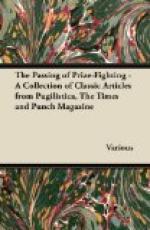After leaving the Galleries, the Scribe and the Artist looked up at the model of Eddystone Lighthouse, and entered a shed declared to be an “Arctic Scene.” Here they were reminded by the introduced ship of those happy days of their boyhood spent in the toy-shops of the Lowther Arcade. Next they visited the Panorama of Trafalgar, and revelled in the carnage of a sea-fight that only required Margate in the distance to be entirely convincing. They glanced at the arena, and gazed with awe at the lake which is to be devoted to the manoeuvring of miniature ironclads. It will be interesting to note whether these mimic combats will hold their own in the coming season against the introduction of capsized clowns, drenched old women, and comic police. Keeping the best for the last, the Scribe and the Artist now entered the model of the Victory—a really admirable exhibition. There they saw before them the old battle-ship with its full equipment, as it was in the days of Nelson—when that deathless hero expected every Englishman (not excluding even those passing the Custom House—as the Committee would say) “to do his duty.” To make the illusion complete, the great sea-captain was observed dying in the cook-pit in the agonies of wax. And to think that this work was executed by a firm of house-decorators! Why, who would not, after this, have his back drawing-room converted into the quarter-deck of the Shannon, and his spare bed-room into a tiny reproduction of the Battle of Copenhagen!
[Illustration: Mr. Punch’s Representatives, after partaking of Chelsea Hospitality (a purely fancy sketch).]




